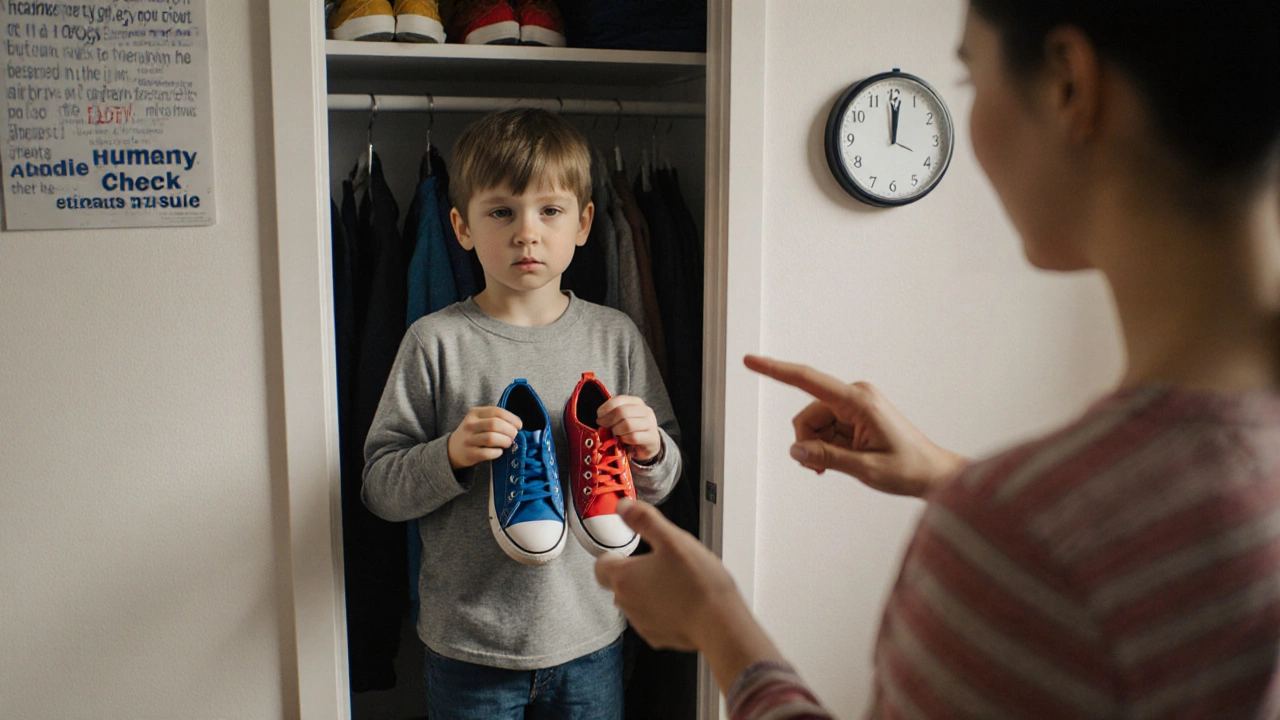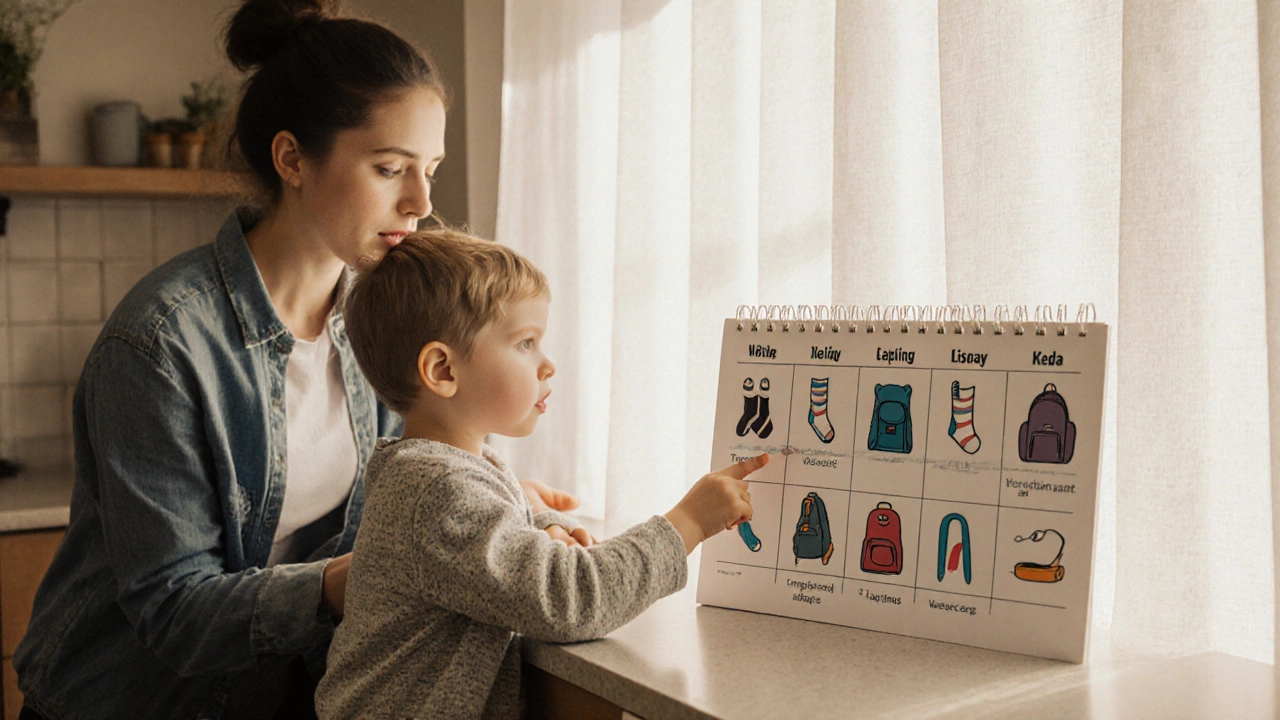Sensory & Stress Assessment Tool
Assess Your Child's Current Stress Level
Identify potential triggers to reduce meltdowns and stubborn behavior. This tool reflects strategies from the article on understanding communication needs.
0
Recommendations
Based on your assessment:
When your child refuses to get dressed, throws tantrums at the slightest change in routine, or shuts down completely when asked to do a simple task, it’s easy to feel like you’re hitting your head against a wall. If your child has special needs - whether autism, ADHD, sensory processing disorder, or another condition - that stubbornness isn’t defiance. It’s communication. It’s fear. It’s overwhelm. And it’s not something you can fix with time-outs or yelling.
Understand Why They’re Stubborn
Stubbornness in special needs children rarely comes from a place of rebellion. It’s usually a reaction to something deeper. A child with autism might resist changing clothes because the tag feels like sandpaper. A child with ADHD might shut down when asked to start homework because their brain can’t figure out where to begin. A child with anxiety might scream when told it’s time for therapy because they associate it with feeling out of control. Research from the University of California, Los Angeles shows that over 80% of challenging behaviors in children with developmental disabilities are rooted in unmet sensory, communication, or emotional needs - not disobedience. When a child says "no" over and over, they’re not trying to win an argument. They’re trying to survive a world that feels too loud, too fast, too confusing.Stop Fighting, Start Framing
The biggest mistake parents make is trying to win the battle. You say, "Put your shoes on." They say, "No." You say, "We’re leaving in five minutes." They scream. You raise your voice. They collapse on the floor. The cycle repeats. Instead of commanding, try framing. Give choices that lead to the same outcome. Instead of "Put your shoes on," say: "Do you want to wear the blue shoes or the red ones?" Instead of "It’s time for math," say: "Do you want to do math before or after snack?" This isn’t about giving in. It’s about giving control where it matters. Children with special needs often feel powerless. When you offer two acceptable options, you’re handing them a piece of agency - and that reduces resistance by up to 60%, according to a 2023 study in the Journal of Autism and Developmental Disorders.Use Visual Schedules - Not Just Charts
A visual schedule isn’t a pretty poster. It’s a lifeline. For kids who struggle with transitions, knowing what’s coming next cuts anxiety in half. But most visual schedules fail because they’re too vague. A good one includes:- Photos or simple drawings of each activity (e.g., a picture of a toothbrush for brushing teeth)
- Clear start and end points (use a "finished" box or Velcro strip to remove completed tasks)
- One step at a time - never list five things at once
Build Routines, Not Rules
Rules change. Routines stick. A rule is "You must brush your teeth." A routine is: "After dinner, we sit at the sink, I hand you the toothbrush, we brush for two minutes while the song plays, then we rinse and put the toothbrush in the cup." Routines work because they’re predictable. The brain doesn’t have to guess what comes next. For children with special needs, predictability = safety. And safety = calm. Start small. Pick one daily task - morning hygiene, bedtime, or lunch prep - and make it non-negotiable in sequence. Do it the same way, every day, at the same time. Use timers if needed. Play the same song. Use the same towel. Consistency builds trust.
Reduce Sensory Triggers Before They Happen
Many "stubborn" moments are actually sensory meltdowns. The fluorescent lights are buzzing. The laundry detergent smells too strong. The chair is too hard. The teacher’s voice is too sharp. Your child can’t tell you this. So they scream. Or freeze. Or run. Keep a simple log for a week: note what happened right before the meltdown. Was it loud noises? Crowded spaces? Certain textures? After a few days, patterns emerge. Then, make small adjustments:- Switch to unscented soap and laundry products
- Use noise-canceling headphones during busy times
- Buy soft, tagless clothing
- Turn off bright lights and use lamps instead
Teach Communication, Not Compliance
If your child can’t say "I’m overwhelmed," they’ll scream. If they can’t say "I need a break," they’ll hit. If they can’t say "That’s too hard," they’ll refuse. Teach them how to ask. Use picture cards. Use simple phrases: "I need help," "I need space," "I don’t want to." Practice these phrases when they’re calm - not in the middle of a meltdown. Apps like Proloquo2Go or even free tools like Boardmaker can help build a visual communication system. You don’t need to be a therapist. Just start with three phrases. Repeat them. Reward them when they use them - even if it’s just a nod or a point.Take Care of Yourself - Or You Won’t Be Able to Help Them
You can’t pour from an empty cup. And if you’re exhausted, angry, or guilty, your child will feel it. They’re hyper-aware of your emotional state. Set aside 10 minutes a day - just 10 - to breathe. Walk around the block. Listen to music. Call a friend. Cry if you need to. You’re not a bad parent for needing a break. You’re a human. Join a local support group. In Wellington, the Special Needs Parents Network meets every Thursday. You’ll find people who get it. People who’ve been where you are.
Progress Isn’t Linear - And That’s Okay
There will be days you think you’ve made progress - and then, out of nowhere, your child goes back to screaming at the sight of a spoon. Don’t panic. This isn’t failure. It’s normal. Behavior change in special needs children happens in waves. Two steps forward, one step back. Then two more. Then a big leap. It’s not a straight line. It’s a zigzag. Celebrate the tiny wins. They put on one sock without being told. They sat at the table for five minutes. They didn’t throw the plate. Those aren’t small. They’re huge.When to Seek Professional Help
You don’t have to do this alone. If:- Behaviors last more than six weeks without improvement
- Your child hurts themselves or others regularly
- You feel like you’re losing your mind
- School or therapy isn’t helping
Final Thought: You’re Not the Problem
Your child isn’t stubborn because you’re doing something wrong. They’re stubborn because their brain works differently. And that’s not a flaw - it’s a difference. The goal isn’t to make them compliant. The goal is to help them feel safe, understood, and capable. When you shift from control to connection, the stubbornness doesn’t vanish - it transforms. And slowly, quietly, your child starts to trust you more than their fear.Is my child’s stubbornness normal for a special needs child?
Yes. Stubbornness, resistance, and meltdowns are common in children with autism, ADHD, sensory processing disorders, and other developmental conditions. These behaviors are often responses to sensory overload, communication difficulties, or anxiety - not intentional disobedience. What’s normal is that the behavior is rooted in their neurology, not their character.
Should I use punishment to stop stubborn behavior?
Punishment rarely works and often makes things worse. Children with special needs often don’t connect punishment with the behavior. Instead, they associate it with fear, shame, or abandonment. This increases anxiety and resistance. Focus on understanding the cause and teaching alternatives, not consequences.
How long does it take to see results with these strategies?
You might notice small changes within a week - like fewer tantrums during transitions. But meaningful, lasting progress usually takes 4 to 12 weeks. It depends on the child’s needs, consistency of the approach, and whether sensory or communication supports are in place. Patience isn’t optional - it’s part of the strategy.
What if my child refuses to use visual schedules or communication tools?
Start even smaller. Don’t force the tool. Introduce it casually. Put a picture of their favorite snack next to the fridge. Say, "Here’s your apple. Want it now?" Point to the picture. Don’t expect them to use it right away. Just make it part of the environment. Over time, they’ll start to notice it. Many children begin using visuals without being taught - because they realize it helps them get what they need.
Can diet or sleep affect stubborn behavior?
Absolutely. Poor sleep and unstable blood sugar can worsen meltdowns and resistance. Many children with special needs have sleep disorders or food sensitivities. Keep a simple log: note sleep hours, meals, and behavior. You might find that skipping breakfast leads to afternoon outbursts, or screen time after 7 p.m. causes nighttime screaming. Small changes here can have big effects.


Write a comment